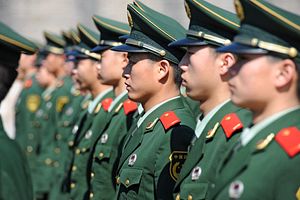Yesterday, China’s State Council Information Office released a white paper on “Chinese Military Strategy” — a rarity for the People’s Republic. This document is notable for several reasons, as commentators both here at The Diplomat and elsewhere have already highlighted. It confirms what U.S. analysts have been saying for some time: Beijing is growing bigger and bolder with its military strategy. China envisions itself as a global player, and is in the process of shifting its strategic core from its land-based troops to its navy. Furthermore, Beijing notes that it won’t initiate a war, but it will strike back if attacked (a modern restatement of Mao’s “active defense” doctrine). In a nutshell, the first part of Chinese Vice Premier Wang Yang’s famous statement — that China “[has] neither the ability nor the intent to challenge the United States” — no longer applies. The second part — intent — remains an open question.
Of course, the timing of this white paper will skew readings, especially in the West and in Southeast Asia. In recent months, all eyes have been on China’s increasing assertiveness in the South China Sea. China is building islands and building facilities, including airstrips, on those islands with a scope and pace unprecedented in the region. In recent weeks, the United States has said that it will begin to challenge the legitimacy of China’s behavior and send ships and planes to assert that despite Beijing’s island building, the sovereignty of these various reefs and islands remains indeterminate.
The United States backed that up last week when it sent a P8 Poseidon surveillance aircraft within a stone’s throw of Fiery Cross Reef, provoking a Chinese military warning, with a CNN crew on board to document the encounter for dissemination in the growing war of public relations between the two countries. While the white paper was not written in response to the incident — it would have been drafted far in advance — the paper does address the general dynamic in disputed areas. To this effect, the white paper notes that “some external countries are also busy meddling in South China Sea affairs; a tiny few maintain constant close-in air and sea surveillance and reconnaissance against China.”
Fair enough.
Still, while the South China Sea is 2015’s flashpoint and while the East China Sea appeared to be the hot flashpoint in late 2013 and early 2014 (it’s admittedly cooled down a bit this year as things heat up down south), in reading China’s white paper, I was reminded of the continuing centrality of Taiwan to the People’s Liberation Army’s posture. Despite all its talk of “[securing] China’s overseas interests” and “[safeguarding] its national sovereignty and maritime rights and interests,” the PLA’s overarching strategic priority remains Taiwan. The Taiwan Strait remains the primary war-fighting scenario for the PLA. In the white paper’s section on China’s national security situation, Taiwan, along with other “separatist forces,” features prominently:
The Taiwan issue bears on China’s reunification and long-term development, and reunification is an inevitable trend in the course of national rejuvenation. In recent years, cross-Taiwan Straits relations have sustained a sound momentum of peaceful development, but the root cause of instability has not yet been removed, and the “Taiwan independence” separatist forces and their activities are still the biggest threat to the peaceful development of cross-Straits relations. Further, China faces a formidable task to maintain political security and social stability. Separatist forces for “East Turkestan independence” and “Tibet independence” have inflicted serious damage, particularly with escalating violent terrorist activities by “East Turkestan independence” forces. Besides, anti-China forces have never given up their attempt to instigate a “color revolution” in this country.
The above passage is an important reminder of China’s strategic priorities, and, when we remember that the PLA is, in fact, not a professional military but the military arm of the Chinese Communist Party, this is more understandable. Despite headline-grabbing events in the East and South China Seas and the PLA-Navy’s expansion westward into the Indian Ocean and the east coast of Africa, stability, unification with Taiwan and internal security are seen as the most critical challenges for China’s national security.
This is not to understate or underemphasize China’s activities in other areas. Rather, it’s a reminder of the enduring sensitivity of the Taiwan issue. In fact, the white paper’s primary assertion — that China would fight back if provoked but not strike first — has important implications for the U.S. response for any future crisis in the Taiwan Strait.

































